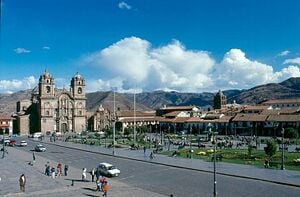
- Trees in Andes to counter Peru's climate and water crisis, says Swiss scientist, Feb 20[1]
2015[edit | edit source]
Peru protects vast 'Yellowstone of the Amazon', November 9[2]
2014[edit | edit source]
In Peru, beach cleanup scheme helps disadvantaged people become entrepreneurs, February 12[3]
2013[edit | edit source]
Peru To Provide Free Solar Power To 2 Million Of Its Poorest Residents By 2016,[4] July 23
2010[edit | edit source]
Marcamasi [es] reports that in Peru more than 8,000 people managed to plant 27,166 trees in 5 minutes and 20 seconds, achieving a new Guinness record, 6 June 2010. This also marks the beginning of a national campaign called "Toward 180 million trees" ("Rumbo a los 180 millones de árboles") with the theme "Let's change our attitude, let's sow a plant" ("Cambiemos de actitud, sembremos una planta").[5] Written by Silvia Viñas, June 6
2008[edit | edit source]
Projects from Peru and Lao PDR share UNEP Sasakawa prize 2008,[6] June 4. Practical Action, founded in 1966, is working in Peru's eastern Andes where 68 per cent of the population - around 5 million people - do not have access to electricity. The project makes use of the region's vast potential for hydroelectricity: to date, 47 micro-hydro schemes have been installed in the area through Practical Action, bringing clean power to about 30,000 people.
Through this project, Practical Action is also boosting local industry, as most of the turbines are manufactured by small companies in Peru to Practical Action designs - with each company making three or four turbines a year. Practical Action says it sees local manufacture as a key step towards widespread use of renewable energy.
The electricity supply is boosting the development of the remote communities. Previously, people moved away to start businesses in places where the infrastructure was better, but the electricity from the micro-hydro schemes has brought them back. Some villages have doubled in size, with people returning and others starting or expanding businesses including restaurants, bakeries, furniture makers, welders and internet cafes.
See also[edit | edit source]
- Peru news (latest), 2008-2017
- Peru community action
References